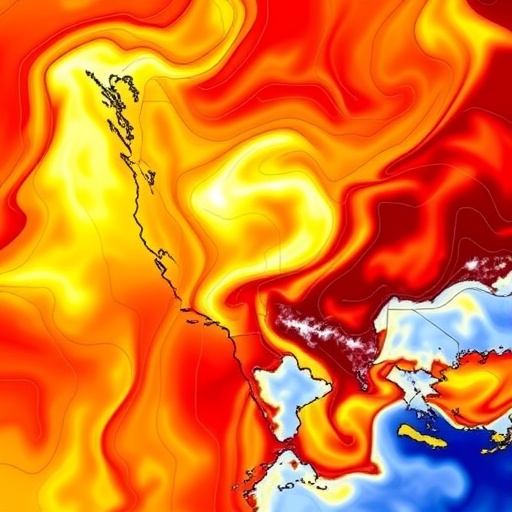In recent years, the intensification of European heatwaves has emerged as one of the most formidable challenges posed by climate change, impacting agriculture, energy systems, public health, and economies across the continent. Addressing this urgent threat requires not only robust climate models but also innovative forecasting techniques capable of predicting extreme heat events well in advance. A pioneering study published in Nature Communications Earth & Environment introduces a breakthrough machine learning framework that promises to transform seasonal heatwave forecasting, offering unprecedented accuracy and efficiency.
Traditional seasonal forecasting methods depend heavily on dynamical climate models, which simulate the atmosphere and oceans based on physical laws. These models, while scientifically rigorous, demand enormous computational resources and often struggle to deliver reliable predictions, especially in northern and central Europe where climate variability is notoriously complex. The newly proposed machine learning-based system circumvents some of these challenges by leveraging data-driven feature selection to identify the key atmospheric, oceanic, and land variables that most strongly forecast continental heatwaves.
Central to this innovative method is an optimization framework that analyzes roughly 2,000 potential predictors, extracting the most informative subset for each specific location across Europe. By focusing computational effort on variables predictive of heatwave likelihood, the algorithm enhances forecasting skill while dramatically reducing the necessary computational power. This cost-effective approach elevates seasonal forecast accessibility, opening opportunities for more widespread use beyond specialized institutions equipped with supercomputers.
Remarkably, the machine learning system demonstrated superior forecast skill in regions traditionally problematic for dynamical models, such as Scandinavia and northern-central Europe. The study attributes this performance boost to the ability of the ML framework to capture complex, nonlinear interactions among climate drivers that conventional models may overlook or inaccurately represent. Such predictive improvements hold significant societal value since these areas are highly vulnerable to heatwave impacts.
One of the most striking insights from the research is the temporal window during which predictors provide maximal forecasting skill. Atmospheric variables gathered four to seven weeks before summer—roughly by mid-March—yield the greatest signal for anticipating extreme summer heat. This lead time provides a critical opportunity for mitigation strategies to be enacted in agriculture, public health, and infrastructure planning, potentially saving lives and reducing economic damages.
The study also reveals that certain local predictors, including soil moisture levels, temperature regimes, and atmospheric circulation patterns, are especially influential in driving regional heatwave occurrences. Beyond these proximate factors, the system identifies remote teleconnections originating from tropical Pacific and Atlantic ocean basins that modulate European summer temperatures. Such findings not only enhance prediction but contribute to the broader understanding of physical mechanisms behind extreme heat events.
A groundbreaking aspect of the research lies in the training of the machine learning models on paleoclimate simulations spanning nearly two millennia, from year 0 to 1850. This extensive synthetic database offers a richness of climate states far exceeding the limited observational period, enabling the models to learn robust patterns of heatwave drivers in a “model world.” Impressively, this knowledge successfully transferred to real-world conditions, effectively forecasting recorded heat events between 1993 and 2016, including catastrophic summers such as 2003 and 2015.
Machine learning’s data-driven nature allowed the researchers to not only improve forecast accuracy but also achieve interpretability by highlighting which feature variables contributed most to predictions in various locations and times. This transparent framework contrasts with typical ML black-box approaches and provides valuable scientific insights. By understanding predictor importance, scientists can refine hypotheses regarding environmental processes that catalyze heatwave formation.
Beyond its practical forecasting benefits, the ML-based framework represents a conceptual shift in climate science, marrying artificial intelligence with physical understanding to tackle complexity efficiently. As one of the lead researchers, Dr. McAdam, notes, machine learning is poised to become a foundational tool for studying climate variability and extreme events. The capacity of ML to distill meaningful signals from vast predictor datasets marks a milestone in climate risk assessment methodologies.
From a computational standpoint, the system achieves its goals while using only a fraction of the resources demanded by conventional dynamical models. This efficiency not only reduces costs but enables faster iterative improvements and broad adoption in research and operational centers worldwide. By concentrating on heatwave prediction—a narrow yet high-impact target—the approach demonstrates the potential for specialized AI methods to complement general-purpose climate models.
The broader implications of dependable seasonal heatwave forecasts resonate across sectors. Early warnings can allow farmers to adjust crop management, energy providers to anticipate demand surges, and healthcare systems to prepare for heat-related illnesses. Furthermore, emergency planners can deploy targeted measures to protect vulnerable populations. As climate projections foresee worsening heatwave intensity, such proactive capabilities become indispensable.
Finally, the CMCC research team envisions extending their framework beyond European heatwaves to other extreme climate events, seasons, and geographic regions. The flexibility afforded by feature selection and ML ensures adaptability for forecasting droughts, floods, or cold spells, embedding this approach in next-generation climate services. This study sets a new benchmark in seasonal forecasting, showcasing a compelling example of how artificial intelligence can accelerate climate resilience in a warming world.
Subject of Research: People
Article Title: Seasonal forecasting of European heatwaves using a feature selection framework
News Publication Date: 4-Nov-2025
Web References:
DOI link
CMCC Website
References:
McAdam R. et al., Seasonal forecasting of European heatwaves using a feature selection framework, Nature Communications Earth & Environment, DOI: 10.1038/s43247-025-02863-4
Keywords: Climate change, heatwave forecasting, machine learning, seasonal prediction, artificial intelligence, European heatwaves, computational efficiency, climate modelling, early warning systems, paleoclimate simulations, atmospheric predictors, climate risk assessment




